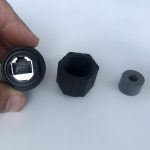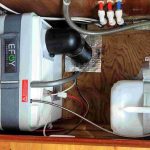For almost a year I hardly used this little control and monitoring panel because the attached EFOY fuel cell was already flawlessly performing its duty: If engine alternator, solar panels, and/or shore power were not keeping Gizmo’s main battery bank at the voltage parameters I’d configured, the EFOY automatically and quietly charged the bank for a variable period also configured.
While the amp hours are expensive — the tested 210 model retails for $5,899, and the company’s methanol fuel costs roughly $10 per 100ah — I’m convinced that an EFOY Comfort could be a very pleasing addition to many cruising sailboats and trawlers, especially as a complement to solar power. The installation, operation and EFOY economics are detailed further below, but first I’ll share a graphical use story.

Gizmo’s battery bank voltage as refrigeration and other loads compete with solar and EFOY charging during a foggy week on a mooring
The graph’s simple plot goes like this: During an overcast and foggy summer week, the beloved but neglected cruising powerboat Gizmo lays on her moored float in Maine, her solar panels not quite able to keep up with the loads imposed on her 440 amp hour battery bank by refrigeration and various electronics like AIS and off boat monitoring. But at about midnight on day two, the alert EFOY Comfort 210 sees the battery voltage sinking to a possibly damaging level and kicks in 8.6 amps for about six hours. Day after day, the dire lack of solar gain continues, but the reliable EFOY valiantly comes to the rescue when needed, until finally the boat’s owner goes for a day trip that more deeply replenishes the battery bank.
It’s a sweet story, I think, though maybe the graph should also include the cold beverages enjoyed onboard several times during that week to better illustrate how pleasant it was not to run the main engine just to make some electricity (microwaving a hot lunch on a dank day excepted). Plus, given that the EFOY 210 can run over 100 hours on a full 2.6 gallon fuel cell, I could have left the boat unattended for many more days and still have had running bilge pumps and cold beer when I got back (and I also would have been alerted by one of the monitoring systems if the power or bilge situation had changed).
And there are very different EFOY boating scenarios that might voltage graph in similar ways. Picture, for instance, sailors on a long passage in a decent breeze, but with power needs or desires beyond whatever their solar, wind or hydro sources could generate… or any kind of cruising boater snugged up in a very quiet cove. These are situations when the near silence of fuel cell generation has great value. Automatic and quiet charging from a lightweight and reliable source produce what I’ve come to think of as premium amp hours
EFOY methanol-fueled chargers are not new — an earlier model line caused quite a Panbo fuel cell conversation in 2009 — but that seems a good thing for an unusual technology that most of us have still never even seen in action. The current EFOY Comfort line has been out in the field for many years, though predominantly in European camper vans, and in 2017 it earned U.S. wholesale distribution and support by the excellent team at Gemeco Marine Accessories. EFOY works and so the question becomes how valuable premium amps are to your boating situation. I’m hoping that the following details will help you decide, but will also happily add that a second round of testing will soon commence.


